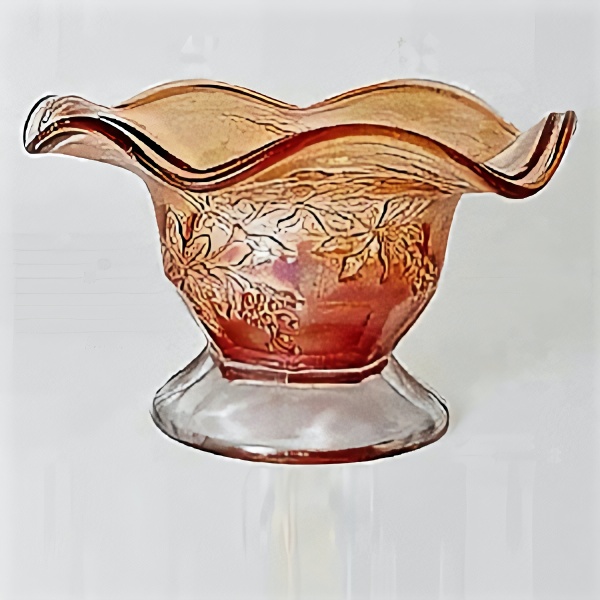Holly and Poinsettia
By Lee Markley
ICGA Carnival Pump Dec 2012
The description of this pattern occurred in the December 2008 issue of The Pump written by Dr. Larry Keig on page eleven. I am quoting from my description in Larry’s larger article: “The piece is seven inches in diameter across the top and three and five‐eighths across the base which is recessed about an inch. There are two mold lines. There are ten panels on the outside that extend onto the base and end in scallops just before the edge.
“The design is on opposite sides of the inside on each mold section. It is plain* between the two groups of flower clusters. There are six** poinsettias in each with two clusters of berries that hang down almost to the base.
“The poinsettias also have stems, but all are on the same branch. Interestingly those two branches extend across the mold lines.
“The piece stands roughly three inches to three and three-‐eighths inches high depending on the ruffles. There are six ruffles. Another interesting thing is a raised rib five‐sixteenths of an inch in from the edge almost like it had been made for something that had an inner rib like a sugar bowl.”
*While re-examining the compote in doing this article, I found an additional design feature. The space between the poinsettia clusters isn’t plain. This space is bisected by the mold line, but it does have a faint design. On one side I discovered at least seven six pointed stars faintly raised from the surface. There may be two more in the row nearest the outer edge which has been stretched when the piece was being ruffled. It would appear that in the row closest to the base there are three stars. One of them placed squarely on the mold line which forms two of the points. I’ve only located two stars in the second row and three may be found in the third row. The center star in this third row is also on the mold line. The end stars are perhaps one quarter inch from a poinsettia. On the other side there are two stars in the first row. These are roughly an inch apart-one above a poinsettia sepal and the other above a cluster of ten berries. The center star in the second row is also on the mold line. There is another star roughly an inch and a half to its right. I didn’t see one to its left. In the third row are two faint stars-one to the right of a poinsettia leaf. The other is roughly three‐quarters of an inch from it.
On the other side there are two stars in the first row. These are roughly an inch apart—one above a poinsettia sepal and the other above a cluster of ten berries. The center star in the second row is also on the mold line. There is another star roughly an inch and a half to its right I didn’t see one to its left. In the third row are two faint stars—one to the right of a poinsettia leaf. The other is roughly three‐quarters of an inch to the left of the top poinsettia on the right side. There didn’t appear to be any more than these two. That portion of the bowl has been stretched in the ruffling making anything indistinct. It would be interesting if the owners of the other two examine theirs carefully to see how the design elements compare.
**Instead of six poinsettias, I found seven on each side. The left side of the bowl also has two berry clusters. One has thirteen berries and the other has ten. On the right side one has ten and the other fourteen.


